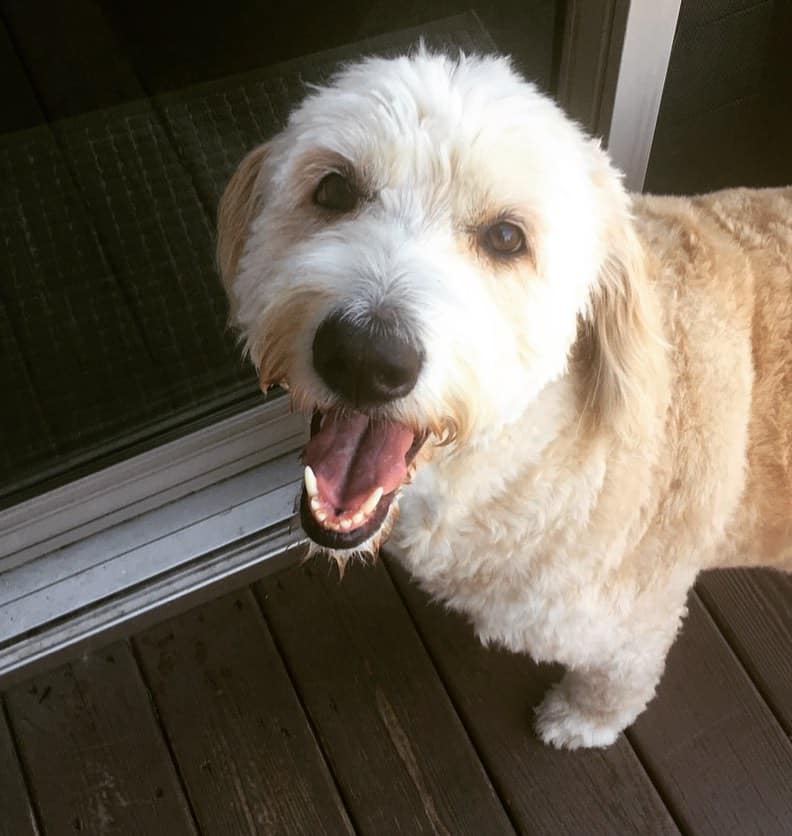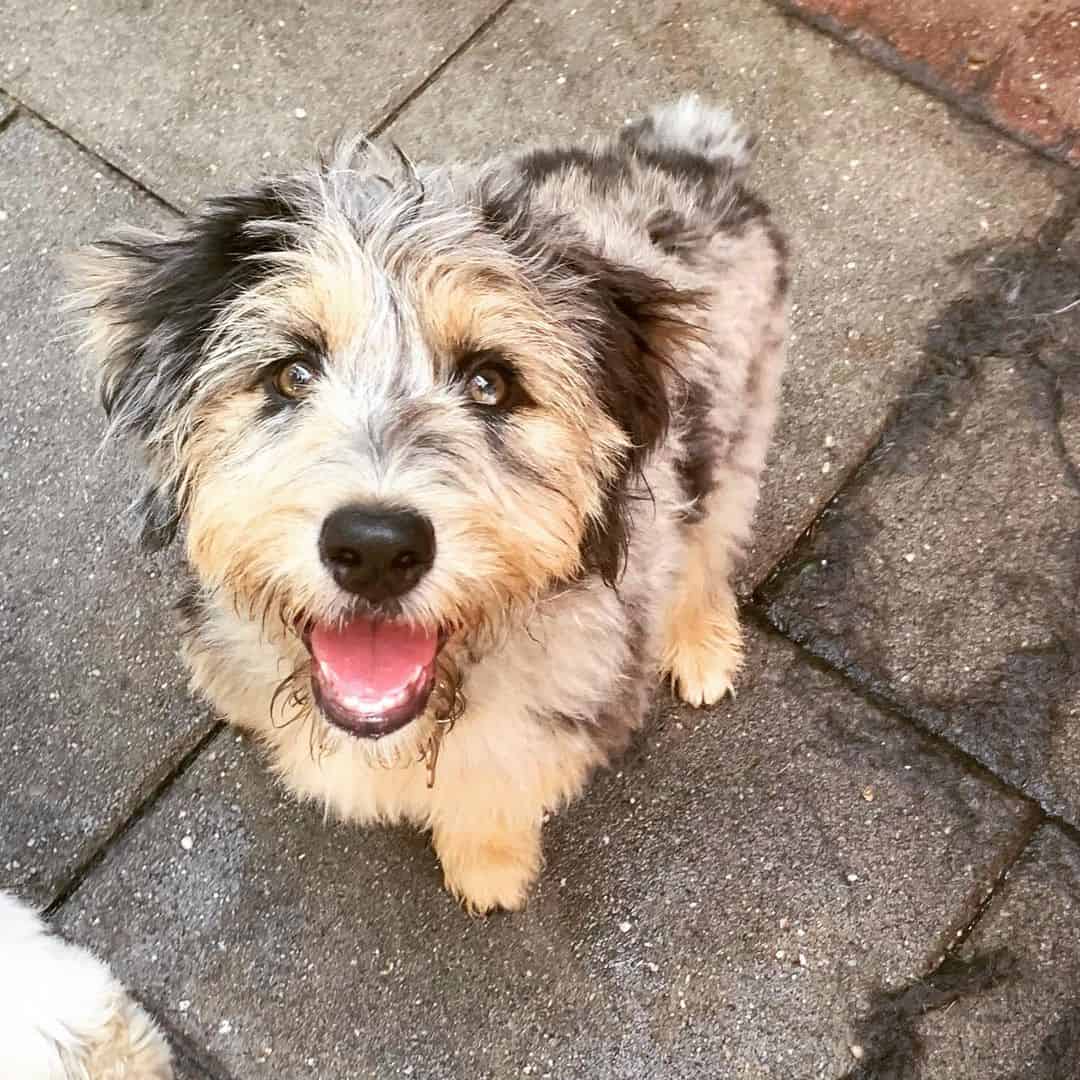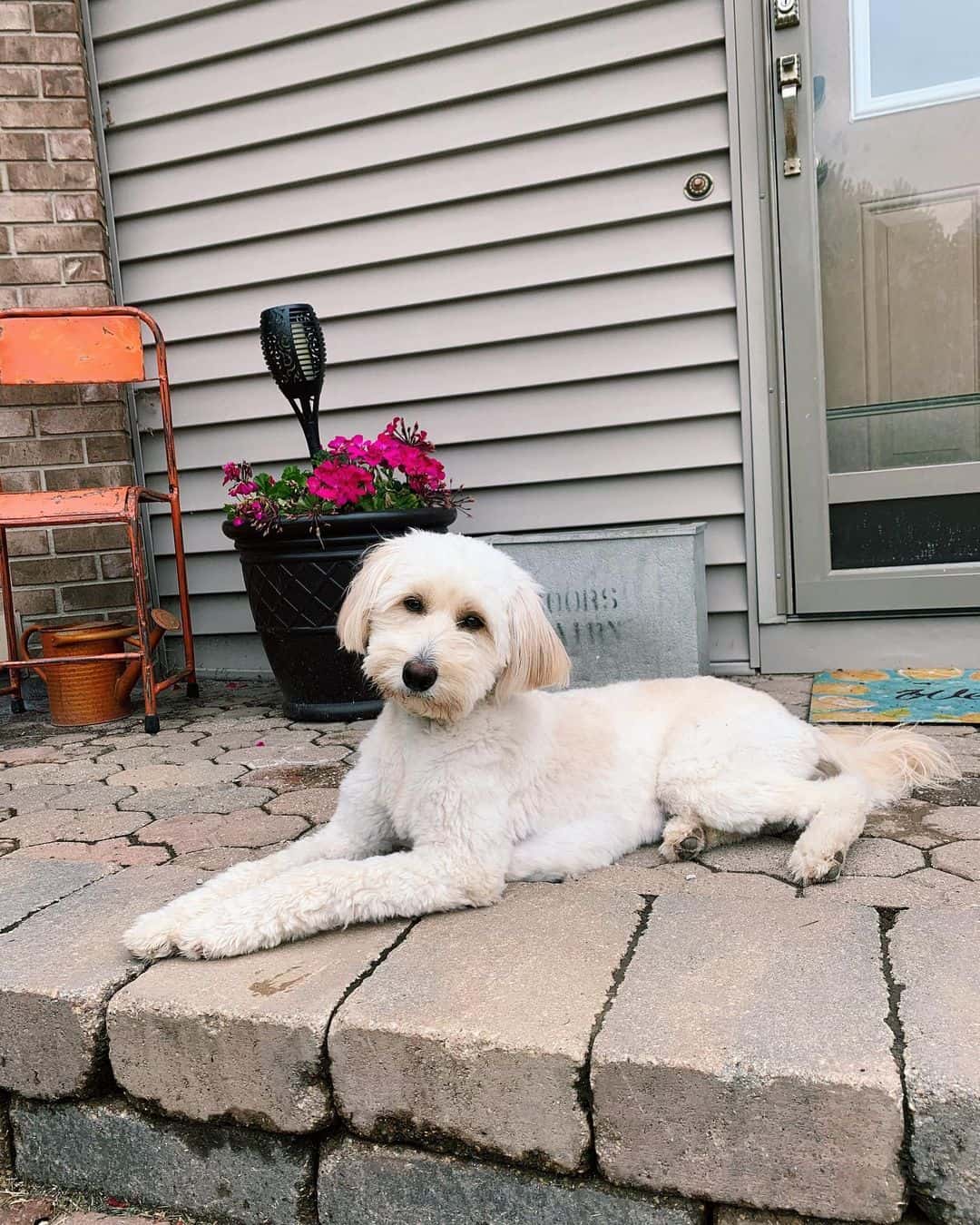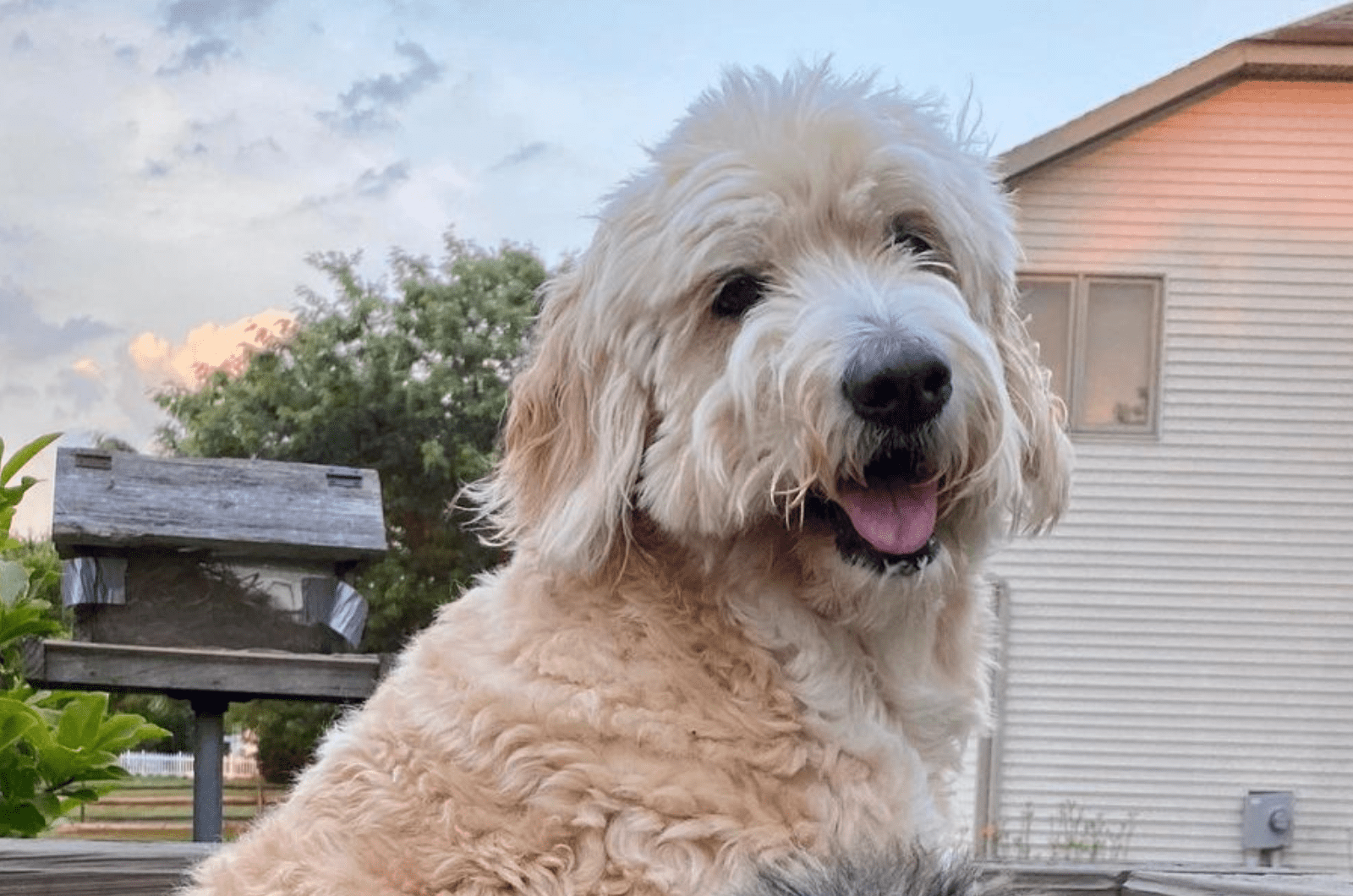Sugar, spice, and everything nice – that is what our Golden Aussiedoodle is made of. But to be honest, there is a little more genetics to it. But we will get to that part later.
There are three adjectives that describe our Golden Aussie very well: compassionate, friendly, and protective. But to be honest, our golden boy is much more than that. But we will also get to that part later.
What we need to know in the beginning is that Golden Aussiedoodle and Australian Goldendoodle are two distinctive mixed breeds. But don’t worry, we were also confused about that in the beginning.
We have gathered a lot of information to help us resolve all this.
Join us on our journey to the land down under to find, meet, and greet our lovely Aussiepoo dog.
What Is A Golden Aussiedoodle?

Photo from: @daisydoozthegoldendoodle
Well, what could it be? Definitely one of the best Doodle breeds out there, I must say. And what are Doodles?
Doodles are simple and colorful drawings that represent certain narratives, but that is not what I meant. In the dog world, a Doodle is a mixed dog breed, where one of the parent breeds is a Poodle.
You see, it even rhymes – Doodle/Poodle.
I asked one breeder to describe his Golden Aussiedoodle to me, and he said his dog was 50% made of Poodle. Did you know that? So what is the rest made of?
Let’s play a guessing game!
If a Doodle is a Poodle, then the Aussie must direct us to a dog from Australia. Well, that is the right clue. So which Australian breed is a parent to our Aussiedoodle puppy?
Is it an Australian Terrier? Well, that doesn’t seem to be likely. Maybe it is an Australian Kelpie? Hmm, maybe, but I don’t think so.
Could it be an Australian Cattle Dog? Well, that seems to be close enough, but still no.
I know, it has to be an Australian Shepherd, then! And that is the correct answer.
The Australian Shepherd makes up 25% of the Golden Aussiedoodle!
50% and 25% still doesn’t make 100% – we have to identify the remaining 25% of the Golden Aussiedoodle. So, does the adjective golden say anything to you?
This 25% of the Golden Aussiedoodle’s genetics belong to the Golden Retriever.
But we are not going to stop there. This is just one of the options. The proportions of genetic impact can be differently dispersed. It all depends on the breeder.
Well, these are some really good genetics here. This is one high-quality Australian Shepherd mix, or should I say Poodle mix? Or is it a Golden Retriever mix, after all?
Well, I guess we will never know. But we do know that we will get the most lovable and smart dogs with this mix.
Golden Aussiedoodle Vs. Australian Goldendoodle
Golden Mountaindoodle, F1 Mini Goldendoodle, Standard Bernedoodle, F1BB Goldendoodle, F1B Labradoodle, English Cream Goldendoodle, Mini Bernedoodle, F1B Sheepadoodle, Micro Labradoodle, it seems like there is no end to these Doodle breeds.
It is easy to get lost in all of it, and to the untrained eye, it is not easy to make the distinction between these mixed breed dogs.
We have already learned that all of them have one thing in common: their Poodle ancestor.
Personally, the most confusing distinction was between the Golden Aussiedoodle and the Australian Goldendoodle.
At first, I thought they were the same. I thought that there were two similar yet different names for the same type of family dog.
What did I do? I asked the breeders!
So here is the thing. This dilemma is easiest to solve when we make the distinction between the parent breeds.
So what two breeds make up the Australian Golden Doodle?
Two breeds in the mix are the Australian Labradoodle and English Golden Doodle.
Let’s repeat once more which breeds make up the Golden Aussiedoodle. They are the Australian Shepherd, Standard Poodle, and Golden Retriever.
So the difference is in the number of breeds and the breeds themselves.
Another thing we will notice here is that the Australian Goldendoodle is made of two Doodle types, so his parents are already mixed dog breeds.
On the other hand, the Golden Aussiedoodle is made of purebred dog breeds such as a purebred Poodle, purebred Golden Retriever, and purebred Australian Shepherd.
The AKC or any other canine club does not register any mix as a distinctive breed.
Generations
We have already mentioned some crossbreeds like the F1 Labradoodle, F1B Bernedoodles, or F1B Cavapoos, for example.
There is the F1 Goldendoodle, F2B Goldendoodle, or F3 Goldendoodle. So why all of these F letters and numbers?
Let’s study it more thoroughly.
Golden Aussiedoodles, like any Goldendoodle puppy or any Doodle at all, depend on the parent breeds. But what does this mean?
All Golden Aussiedoodles won’t be the same when it comes to being hypoallergenic, for example, or when it comes to shedding (this means more or fewer visits to a groomer) and so on.
This is the part where genetics step in and work out all the features that a dog will have.
What Are Fs And What Are Numbers?
F stands for a filial hybrid. It simply means that an F dog is a hybrid dog, which means they are not a purebred dog.
There is sometimes the letter B in the name, and it has a meaning too.
B means backcross, and it means that it is bred back to a purebred dog. This applies to mixes that have only two parents in combination.
The Number means the generation of a dog. This is simple. For example, 1 means first generation, 2 means second generation, and so on.
These are just a few basic genetic terms, but the whole story has a lot more depth to it. But it is a whole nother theme, and we will leave it for another time.
Physical Characteristics Of The Golden Aussiedoodle

Photo from: @kalitheminiaussiedoodle
What can you expect from a dog that is a cross of a Golden Retriever, Poodle, and Australian Shepherd? Well, I guess, a lot of shedding. But it isn’t that bad if you learn how to deal with it properly. But we will get to this soon.
Let’s talk about appearance first.
It is always hard to talk about the average size and weight of mixed breed dogs. And it is especially difficult to talk about the average size and weight of a dog that has three purebred breeds in a mix, like in the case of our Golden Aussiedoodle.
So what can we do to bring us closer to the average numbers?
All we can do is see what the average numbers are for parent breeds.
Appearance
If we think about it, we can conclude that the standard sizes of all the breeds are similar. Neither of these dogs is giant or small (except if we are talking about miniature versions of these dogs, like the Miniature Poodle, for example).
The Golden Retriever parent standard can reach a size of between 22 and 26 inches and weigh up to 80 pounds.
The Poodle parent standard usually reaches between 18 and 24 inches in height and 40 and 70 pounds in weight, depending on sex.
The Australian Shepherd parent standard reaches between 18 and 23 inches and 40 to 60 pounds.
We can see that there isn’t a huge difference between these breeds, so the offspring should be somewhere in between.
But let’s check this out more thoroughly.
How Big Do Golden Aussiedoodles Get?
The Golden Aussiedoodle is still not a frequently seen mixed breed, but it certainly should make a great family pet, considering his ancestors and heritage.
But we still can not talk about its average features because there is still not enough information on this lovely pooch.
But there is a bit more information on his predecessor, the Aussiedoodle, a dog that has been with us for a while. So there are some average numbers on this breed that I think we should look at.
This hybrid breed without the golden adjective, an Aussiedoodle, should be between 14 and 25 inches tall. This fits in with the numbers we mentioned earlier.
Your Doodle from Australia should be somewhere between 25 and 75 pounds in weight, which is also within our measurements.
The life expectancy for an average Aussiedoodle is somewhere between 10 and 14 years, which is also within expectations.
So the features of this herding dog should be applicable to the Golden version too.
But we will have to wait a while before we are able to definitively tell how big Golden Aussiedoodles get.
To repeat once more, it depends on the parent breed’s features and the genetic game in the back. It could be a lottery or intentional breeding, but with crossbreeds, it is always hard to tell.
If you want to sweeten up your life even more, check out these miniature Doodle breeds.
Coat And Colors Of A Golden Aussiedoodle
Oh, the splendor of the coat and colors of a Golden Aussiedoodle. I guess that one can expect a bit of gold in this dog. Well, for sure, because there is one golden parent there.
Same as with colors, coat type would be influenced by the genes of the parent breeds, and all of them have some really dense and thick dog hair. Poodles, for example, have a wavy coat, and there is a big possibility that the offspring will have that too.
So let’s put it all together. Considering all the coat types of the parent breeds, we can expect dense hair that is mid to long. Since the dogs in the mix have straight or wavy hair, it is possible for puppies to express both variations.
When we talk about colors, then there are many variations that we can count on.
Ok, now, first imagine Australian Shepherd colors, then imagine Poodle colors, and then add the gold from Golden Retriever. What do we have here now?
We can count on red, dark golden, golden, cream, light golden, merle, blue merle (for example, there is a blue merle Aussiedoodle), sable, apricot, red merle, gray-black, white, tri-color, and many more.
So many choices we have here.
Read Also: Aussiedoodle Colors – The Art Of Doodles
Do Golden Aussiedoodles Shed?
As we have mentioned many times in this article, it depends a lot on the genetics. If our dog takes after the Poodle parent, there is a great chance that we will not have much trouble with dog hair around the house or allergies.
On the other hand, if it takes after the Australian parent, then we will realize how much Australian Shepherds actually shed.
The same applies to the Golden Retriever.
But we have information that can bring us a bit closer to a conclusion. We can find out if Aussiedoodles shed. And here we have some good news! Aussiedoodles are low shedders, which means that there is a high possibility that our golden boy will be too.
Now, the only thing we should check out is how to do those adorable Aussiedoodle haircuts.
There are a few hairstyle recommendations that will make a Golden Aussiedoodle look super cute. First up, you can try the popular teddy bear haircut. It makes the pooch look super adorable and teddy bear-like.
And there is the stylish Goldendoodle Mohawk that will make a dog look trendy and up to date. And there is the classic lion cut and lamb cut if you want him to look very dangerous or very meek.
Enjoy, and let your imagination work for you and your puppy!
Personality Traits Of A Golden Aussiedoodle

Photo from: @kalitheminiaussiedoodle
There is another note on the Golden Aussiedoodle that I haven’t mentioned before. Some people call the cross of the Goldendoodle and Aussiedoodle this, so there might be some confusion. And it changes the game a bit because it can affect both the physical and personality traits of the offspring.
But we will stick with our definition of the Poodle, Australian Shepherd, and Golden Retriever mix.
So once again, what can you expect of such a combination?
I will give you a task now. Try to imagine each of these dogs separately. What do you see? Can you tell me how you imagine them? Which are their most prominent traits?
How do these dogs behave?
Let’s take a further look at the Aussiepoo’s behavior and temperament.
What Is A Golden Aussiedoodle’s Temperament?
All of the dogs in this mix are loyal working dogs. They are also very smart. All herding and hunting dogs are known to be intelligent.
This means that their offspring, too, will need quite a lot of mental stimulation.
His temperament should be playful and perky. He may be good with kids, but you should still not leave them alone with really small children (you can get a closer insight by studying the Australian Shepherd’s behavior toward kids).
These dogs are not happy when they are left alone for long hours, so they suit homes where somebody is always in the house best.
If you are not ready to make them a family member and give them the attention they need, then this is a dog you should avoid.
Training And Exercise
To be frank, these dogs need a lot of training and exercise a day. This means they are a good choice for active people and a less good choice for less active people.
This means that older people would probably become exhausted if they are not very fit.
Why is this so?
Well, all the parent breeds in the mix are super smart field working dogs. Both the Poodle and the Retriever are hunters, while Australian Shepherds are one of the best herding dogs out there.
So the energy level in their offspring is beyond average. This means that you better get some good running shoes on Amazon and get in shape. You will have to catch a drill.
Health Issues Of A Golden Aussiedoodle

Photo from: @ruthie.bea.coors
Like in many other dog breeds, there are some health conditions that are typical for many dog breeds, both purebreds and mixed breeds. Sometimes, mixed breeds are more prone to certain health problems.
These issues affect both a dog’s lifespan and quality of life (also for the owner) because they require a lot of vet check ups and expensive and long treatments.
That is why prevention is the best option if possible. And to prevent something, you need to know what you are dealing with. So here are the most common issues that bother both dogs and their owners.
Hip dysplasia and elbow dysplasia
As the name says, these are problems that affect the hips and elbows. And what do those two have in common? They are both joints that allow a dog to move.
And moving around is one of the things that he likes to do most, especially for a dog like the Golden Aussiedoodle.
But if moving around hurts, like is the case with hip and elbow dysplasia, you suddenly don’t enjoy hikes, walks, or runs like you used to because it induces discomfort.
But it is not the discomfort that is the problem here. There are further problems that can appear, such as arthritis and more serious damage. The key is prevention through diet and exercise.
Eye problems
Poodles are prone to cataracts. This means that our Aussiepoo can get this disease too. What happens is that eyes go cloudy, which can cause blindness in dogs that don’t receive treatment.
The best way to deal with this is through early treatment. When noticed in the early stages, this condition can be treated with eye drops.
Also, many breeders do a lot of genetic testing before they decide to breed their dogs. This is another way to prevent these types of problems.
If the parent does not carry the gene for a problem, then the offspring shouldn’t express it.
Other issues
Aussiedoodles are known to be prone to skin allergies, which might be a problem a Golden Aussiedoodle could suffer from too.
There are some conditions that might appear but are less frequent. One of those is Von Willebrand disease and bloat.
Conclusion On The Golden Aussiedoodle
So what can one expect from the Golden Aussiedoodle?
Considering his parent breeds, we can expect a smart pooch that will be a loyal family member, a high energy working dog that you can always rely on.
This is a pup with an awesome personality and super fine temperament. This means a lot of fun times together and a lot of cuddles on long afternoons.
Tell us, what do you think about the Golden Aussiedoodle? Is it a kind of Doodle that you can imagine having at home? Or maybe you can imagine yourself with a Mini Golden Aussiedoodle?
I think no one can resist those lovely curls.
Read More:
Australian Shepherd Growth Chart: Your Guide To Aussie Puppy Growth
Dalmatian Poodle Mix: A Spot On Adorable Doodle!
